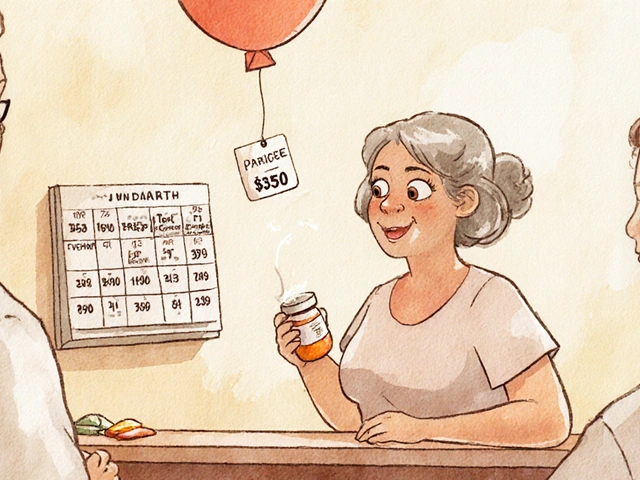
When doctors need to tame stubborn muscle spasms, they often turn to Lioresal, the brand name for the drug baclofen. It’s a go‑to for conditions like multiple sclerosis, spinal cord injury, and certain types of chronic back pain. But you’re not stuck with one option - several other muscle‑relaxant medicines can do the job, each with its own quirks. Below you’ll find a straight‑forward comparison that walks you through how Lioresal stacks up against the most common substitutes, so you can decide which fits your health needs and lifestyle best.
Lioresal works by dampening nerve signals that cause muscles to tighten abnormally. Think of it as lowering the volume on a blaring speaker - the signal is still there, but it’s far less disruptive. The goal is to give you smoother movement, less pain, and a better quality of life. Still, the drug isn’t a magic bullet; side effects, dosing schedules, and cost can vary wildly compared with its rivals. Let’s break it down.
Why Lioresal Might Be Your First Pick
Here are the core reasons many clinicians start with Lioresal:
- Targeted action: Baclofen binds to GABA‑B receptors in the spinal cord, directly reducing muscle tone without heavily sedating the brain.
- Proven track record: Approved by the FDA in 1977, it’s been studied extensively in clinical trials for spasticity.
- Oral flexibility: Available as tablets and a liquid formulation, making it easy for patients who have swallowing difficulties.
Key Alternatives to Consider
Below are the most frequently prescribed substitutes, each with a brief snapshot of how they differ from Lioresal.
Tizanidine - a short‑acting alpha‑2 adrenergic agonist that works in the brainstem to relax muscles. It’s often used when a rapid onset is needed.
Diazepam - a benzodiazepine that boosts GABA‑A activity, offering both muscle relaxation and anxiety relief.
Dantrolene - a direct‑acting agent that blocks calcium release from the sarcoplasmic reticulum, useful in severe spasticity and malignant hyperthermia.
Clonazepam - another benzodiazepine with strong antispastic properties, typically reserved for stiff‑person syndrome.
Carisoprodol - a centrally acting muscle relaxant that converts to meprobamate, often used for short‑term relief of acute musculoskeletal pain.
Side‑Effect Profile: What to Watch For
Every medication comes with trade‑offs. Below is a quick look at common adverse events for each drug.
- Lioresal (baclofen): drowsiness, dizziness, weakness, constipation; abrupt withdrawal can cause seizures.
- Tizanidine: dry mouth, fatigue, hypotension, liver enzyme elevation.
- Diazepam: sedation, memory impairment, risk of dependence, respiratory depression at high doses.
- Dantrolene: muscle weakness, hepatotoxicity (requires regular liver function tests), diarrhea.
- Clonazepam: sedation, ataxia, potential for tolerance and withdrawal.
- Carisoprodol: drowsiness, dizziness, risk of abuse, especially when combined with opioids.

Cost and Accessibility Overview
Price can be a deciding factor, especially if you’re paying out‑of‑pocket.
- Lioresal - generic baclofen is inexpensive (about $0.10 per 10 mg tablet in the US); brand‑name versions are pricier.
- Tizanidine - generic is moderate ($0.20‑$0.30 per 4 mg tablet).
- Diazepam - very low cost as a generic ($0.05 per 5 mg tablet).
- Dantrolene - higher due to limited manufacturers (≈ $0.50 per 25 mg capsule).
- Clonazepam - cheap generic ($0.07 per 0.5 mg tablet).
- Carisoprodol - low to moderate ($0.15 per 250 mg tablet).
Side‑by‑Side Comparison Table
| Drug | Primary Mechanism | Typical Daily Dose Range | Key Side Effects | Average Cost (US, generic) |
|---|---|---|---|---|
| Lioresal (baclofen) | GABA‑B receptor agonist | 5‑80 mg divided 3× daily | Drowsiness, weakness, constipation | ≈ $0.10 per 10 mg tablet |
| Tizanidine | α‑2 adrenergic agonist | 2‑8 mg 3× daily (max 36 mg) | Dry mouth, hypotension, LFT rise | ≈ $0.25 per 4 mg tablet |
| Diazepam | Benzodiazepine (GABA‑A) | 2‑10 mg 2-3× daily | Sedation, dependence, respiratory risk | ≈ $0.05 per 5 mg tablet |
| Dantrolene | Ryanodine‑receptor blocker | 25‑400 mg 3-4× daily | Weakness, hepatotoxicity, diarrhea | ≈ $0.50 per 25 mg capsule |
| Clonazepam | Benzodiazepine (GABA‑A) | 0.5‑2 mg 2-3× daily | Ataxia, tolerance, withdrawal | ≈ $0.07 per 0.5 mg tablet |
| Carisoprodol | Central nervous system depressant | 250‑350 mg 3× daily (max 2 g) | Drowsiness, abuse potential | ≈ $0.15 per 250 mg tablet |
How to Choose the Right Option for You
Pick a medication based on three practical lenses: your medical condition, lifestyle, and risk tolerance.
- Condition specificity: If spasticity stems from a central nervous system disorder (MS, SCI), baclofen’s GABA‑B action is usually most effective. For brief flare‑ups, tizanidine’s rapid onset can be handy.
- Side‑effect concerns: Patients prone to liver issues should steer clear of tizanidine. Those worried about dependence might avoid benzodiazepines like diazepam or clonazepam.
- Cost constraints: When budget tight, generic baclofen or diazepam are the cheapest routes.
Always discuss these factors with a pharmacist or neurologist. They can tailor the dose, schedule, and monitoring plan to keep you safe.
Practical Tips for Managing Muscle‑Relaxant Therapy
- Start low, go slow - most drugs work best when you begin with the smallest dose and increase gradually.
- Never stop baclofen abruptly - taper down over several days to avoid seizures.
- Monitor liver enzymes if you’re on tizanidine or dantrolene - a simple blood test every 2‑3 months is enough.
- Stay hydrated and maintain a balanced diet - helps counter constipation from baclofen.
- Combine meds with physical therapy - drugs relax the muscles, but therapy teaches you how to move safely.
Frequently Asked Questions
Can I take Lioresal and tizanidine together?
Combining two central muscle relaxants can increase sedation and respiratory depression. Doctors sometimes use a low dose of each for refractory spasticity, but it requires close monitoring and a clear taper plan.
What’s the biggest safety concern with baclofen withdrawal?
Abruptly stopping baclofen can trigger severe symptoms: high fever, rebound spasticity, hallucinations, and even seizures. A doctor‑guided taper over 1‑2 weeks is essential.
Is dantrolene safe for long‑term use?
Dantrolene is effective for chronic spasticity, but its risk of liver toxicity means doctors schedule regular liver function tests. If liver enzymes rise, the drug must be stopped.
Do benzodiazepines like diazepam cause muscle weakness?
Yes. Because they enhance GABA‑A activity throughout the brain, they can produce generalized sedation and muscle weakness, which may worsen balance in older adults.
How do I know if baclofen is working for me?
Track your spasm frequency, pain scores, and functional abilities (e.g., walking distance). If you notice a steady drop in spasm intensity over 2‑3 weeks without intolerable side effects, the dose is probably effective.
Bottom Line
Choosing the right muscle‑relaxant is a balance of how the drug works, how it fits your daily routine, and what side effects you can tolerate. Lioresal remains a solid first‑line choice for many due to its targeted GABA‑B action and low cost, but alternatives like tizanidine, diazepam, dantrolene, clonazepam, and carisoprodol each have niches where they shine. Talk with your healthcare team, weigh the pros and cons in the table above, and monitor your response closely - that’s the fastest route to smoother movement and less pain.







Carla Taylor
October 24, 2025 AT 12:56Just remember, every little improvement counts!
Kathryn Rude
October 26, 2025 AT 19:29One might argue that the exhaustive list of side effects is a mere distraction from the true cost-your sanity when the meds fail to cooperate 😊
Amanda Vallery
October 28, 2025 AT 21:29Baclofen actually binds GABA‑B not GABA‑A as many think.
Marilyn Pientka
October 30, 2025 AT 20:43The ethical calculus of prescribing a drug with withdrawal‑induced seizures cannot be ignored; clinicians bear a fiduciary responsibility to implement taper protocols that mitigate iatrogenic neurotoxicity.
Jordan Levine
November 1, 2025 AT 17:09Yo, this drug talk feels like a battlefield-our bodies are under siege and only the fiercest medics can win the war! 🇺🇸💥
Jacqueline Galvan
November 3, 2025 AT 10:49When evaluating baclofen against its peers, it is prudent to begin with pharmacodynamics: baclofen is a selective GABA‑B receptor agonist, which reduces excitatory neurotransmission at the spinal level without profound central sedation. Its onset of action typically spans 30‑60 minutes, allowing clinicians to titrate the dose in a controlled fashion. Compared with tizanidine, which exerts its effect via α‑2 adrenergic pathways, baclofen offers a more predictable dose‑response curve. The side‑effect profile of baclofen, while notable for drowsiness and constipation, lacks the hepatotoxic risk inherent to tizanidine and dantrolene. Cost considerations further favor baclofen, as generic tablets are widely available at a fraction of the price of many alternatives. Moreover, the oral liquid formulation provides a valuable option for patients with dysphagia, a feature not shared by all competitors. In terms of drug interactions, baclofen demonstrates a relatively low propensity for cytochrome P450 involvement, simplifying polypharmacy management. Monitoring requirements are modest; routine liver function tests are unnecessary unless the patient is concurrently on tizanidine or dantrolene. Nevertheless, clinicians must remain vigilant for the potential of withdrawal seizures, which mandate a gradual taper upon discontinuation. Patient education should emphasize the importance of adherence and the dangers of abrupt cessation. Physical therapy remains an essential adjunct, as muscle relaxants alone do not restore motor control. For patients with comorbid anxiety, the use of benzodiazepines such as diazepam may be justified, but the risk of dependence must be weighed. When severe spasticity persists despite optimal baclofen dosing, a trial of dantrolene may be appropriate, provided liver enzymes are closely monitored. Ultimately, the choice of agent should be individualized, reflecting the patient’s medical history, lifestyle, and tolerance for side effects. Regular follow‑up appointments allow for dose adjustments and assessment of therapeutic efficacy. By integrating these considerations, healthcare providers can optimize spasticity management and improve quality of life for their patients.
Teya Arisa
November 5, 2025 AT 01:43Great summary! Remember to keep a medication diary; noting how each dose affects your spasm frequency can guide your doctor toward the perfect balance 😊.
Kester Strahan
November 6, 2025 AT 13:49The synaptic inhibition via GABA‑B can be likened to a dampening knob on a amp-turn it down and you get less over‑excitation but you also risk under‑drive if you go too low.
HILDA GONZALEZ SARAVIA
November 7, 2025 AT 23:09I’ve found that rotating between baclofen and tizanidine on alternate days can sometimes smooth out tolerance, but it requires close monitoring. Be sure to discuss any schedule changes with your neurologist to avoid unexpected dips in control. Also, staying hydrated helps mitigate constipation from baclofen.
Lindy Hadebe
November 9, 2025 AT 05:43The table is clear, though a visual chart could enhance readability.
Michelle Capes
November 10, 2025 AT 09:29It’s tough juggling side effects and cost, but you’re not alone-many patients share your struggle 😔.
Dahmir Dennis
November 11, 2025 AT 10:29Ah, the eternal debate over which muscle relaxant reigns supreme-truly the pinnacle of medical intrigue. One might think that a simple table could settle the matter, yet we labor under the illusion that more data equals clearer decisions. The reality is that each drug carries its own baggage, a fact that seasoned clinicians accept with a weary sigh. Baclofen’s modest price tag is appealing only until the patient confronts the specter of withdrawal seizures. Meanwhile, tizanidine’s hepatic warnings feel like a bureaucratic hurdle designed to keep us all on our toes. Benzodiazepines, with their seductive promise of sedation, inevitably drag patients into the abyss of dependence. Dantrolene’s liver toxicity is a reminder that no miracle solution exists without a price. Even carisoprodol, the so‑called “quick fix,” leaves a trail of abuse potential that tarnishes its convenience. In the end, the “best choice” is a subjective construct shaped by individual physiology, financial constraints, and personal tolerance. So, let’s cease the grandiose proclamations and focus on pragmatic, patient‑centered care.
junior garcia
November 12, 2025 AT 08:43Indeed, the melodrama of drug selection mirrors the theater of life-every act demands thoughtful direction.